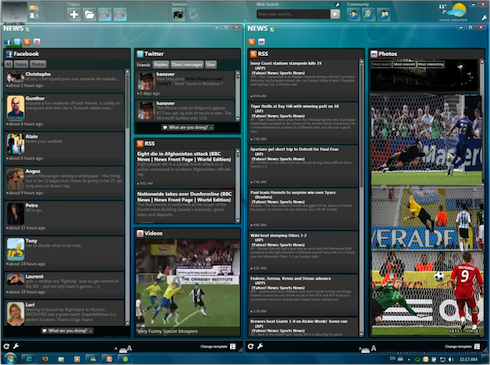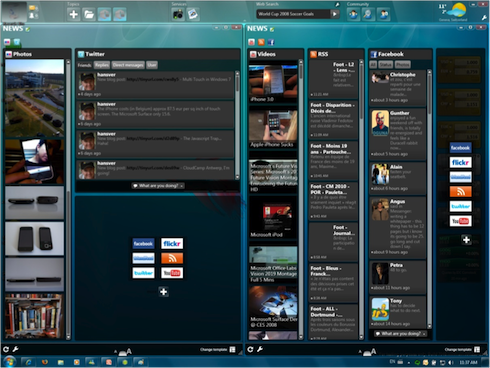
The Newspaper Association of America cast a wide net this summer in seeking proposals for generating online revenue. Their request went out to many of the firms we’ve been covering closely but also several tech companies that aren’t exactly in the thick of the news industry, including Google, Microsoft, IBM, and Oracle.
I thought there was big news in Google’s response, but most of the big-name replies amounted to a glorified catalog of existing services — in other words, lip service. Oracle and IBM discussed content management systems that have been on the market for years. Microsoft’s response was similar, but it also included an intriguing screen shot of an unreleased product it calls the “Next-Generation Newspaper.”
[UPDATE, 3:43 p.m.: Two commenters point out that Microsoft’s screenshots depict an existing program called Sobees. I’m checking with Microsoft for some clarity. Wednesday, 7 a.m.: Rainer Kellerhals, a Microsoft spokesman, clarifies that the user interface was developed with Sobees to demonstrate Microsoft’s ideas about aggregating and monetizing news and information. He says it “does not show a current or future Microsoft product.” I’ve added some other information below.]
As you can see in the image above (larger version), the concept bears a close resemblance to TweetDeck, the application of choice for power users of Twitter and other social networks. It’s just taking TweetDeck to its logical conclusion, pulling in RSS feeds, photos, and video from news providers and placing all that content alongside your friends’ status updates on Facebook and Twitter. Think of it as a surging river of news spilling over its banks. Microsoft describes the concept this way:
The Next-Generation Newspaper is the user’s information hub, aggregating content from different sources and matching it to the user’s profile, preferences, and context (situation). It is accessible from any device, both online and offline, and helps the user to navigate the content universe through search, links, and recommendations. Content and audiences are monetized through pay-for-content and advertising.
Whether anyone wants all their information in one application is an open question, though it would be unfair to judge Microsoft’s vision based on a screenshot and some promotional text. Rainer Kellerhals, a spokesman for Microsoft, described their next-generation newspaper as a “concept” but said it “currently exists as a slide deck and a high-level reference architecture, with pilot implementations under way at some pilot customers.” Kirsten Roach, an account manager for Microsoft who produced the company’s response to the NAA, told me that an announcement related to the next-generation newspaper could be made at the end of this month.
While these details are emerging from Microsoft’s response to the NAA, it’s hard to see this product doing much for newspapers, next-generation or otherwise. The whole point seems to be drawing content from a broad array of sources and disassociating it from point of origin — the same issues already troubling most newspaper companies. And I found it mildly amusing, though also heartening, that Microsoft’s screenshots include streams from, among other rivals, Google’s YouTube and Yahoo’s Flickr.
What’s clear, particularly in the screenshot below (larger version), is that news providers will share just a small slice of the content that people choose to consume. The particulars of Microsoft’s interface aside, that seems like a realistic vision.

UPDATE, Wednesday, 7 a.m.: In an email, Kellerhals shared some of the ideas that the next-generation newspaper is intended to demonstrate:
Making available (and monetizing) individual content elements (articles, images, videos) which today are aggregated into newspapers, giving the customer more choice over what she/he wants to read, and which source he/she prefers. At the same time, many readers will still be interested in getting a “news overview”, i.e. editorially selected, prioritized and organized content.
Acknowledging that “editorial” and “social” content will co-exist and may complement each other. In traditional newspapers, the “letters to the editor” can only be published the day after or days after the article they refer to, “disconnecting” them from the original article; in online media, readers’ comments become part of a dialogue on the subject discussed in the article, providing more insight and additional perspectives on the subject.
People use computers to quickly find information, but they tend to prefer the print reading experience over the on-screen reading experience. Ideally, future news media will combine the readability and portability of print media with the accessibility of online media.